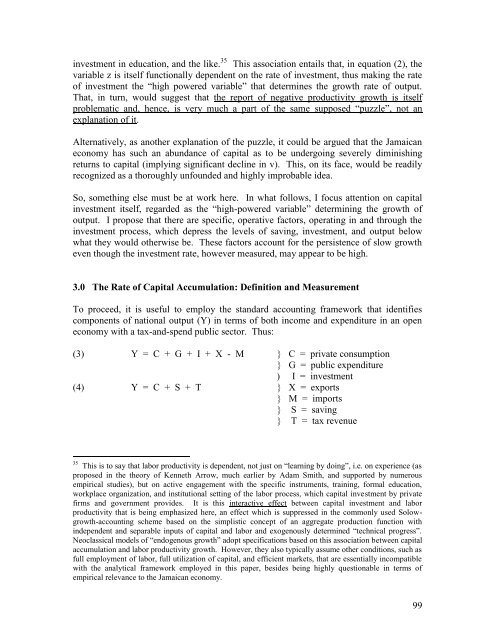PIOJ Growth-Inducement Strategy - Planning Institute of Jamaica
PIOJ Growth-Inducement Strategy - Planning Institute of Jamaica
PIOJ Growth-Inducement Strategy - Planning Institute of Jamaica
Create successful ePaper yourself
Turn your PDF publications into a flip-book with our unique Google optimized e-Paper software.
investment in education, and the like. 35 This association entails that, in equation (2), the<br />
variable z is itself functionally dependent on the rate <strong>of</strong> investment, thus making the rate<br />
<strong>of</strong> investment the “high powered variable” that determines the growth rate <strong>of</strong> output.<br />
That, in turn, would suggest that the report <strong>of</strong> negative productivity growth is itself<br />
problematic and, hence, is very much a part <strong>of</strong> the same supposed “puzzle”, not an<br />
explanation <strong>of</strong> it.<br />
Alternatively, as another explanation <strong>of</strong> the puzzle, it could be argued that the <strong>Jamaica</strong>n<br />
economy has such an abundance <strong>of</strong> capital as to be undergoing severely diminishing<br />
returns to capital (implying significant decline in v). This, on its face, would be readily<br />
recognized as a thoroughly unfounded and highly improbable idea.<br />
So, something else must be at work here. In what follows, I focus attention on capital<br />
investment itself, regarded as the “high-powered variable” determining the growth <strong>of</strong><br />
output. I propose that there are specific, operative factors, operating in and through the<br />
investment process, which depress the levels <strong>of</strong> saving, investment, and output below<br />
what they would otherwise be. These factors account for the persistence <strong>of</strong> slow growth<br />
even though the investment rate, however measured, may appear to be high.<br />
3.0 The Rate <strong>of</strong> Capital Accumulation: Definition and Measurement<br />
To proceed, it is useful to employ the standard accounting framework that identifies<br />
components <strong>of</strong> national output (Y) in terms <strong>of</strong> both income and expenditure in an open<br />
economy with a tax-and-spend public sector. Thus:<br />
(3) Y = C + G + I + X - M } C = private consumption<br />
} G = public expenditure<br />
) I = investment<br />
(4) Y = C + S + T } X = exports<br />
} M = imports<br />
} S = saving<br />
} T = tax revenue<br />
35 This is to say that labor productivity is dependent, not just on “learning by doing”, i.e. on experience (as<br />
proposed in the theory <strong>of</strong> Kenneth Arrow, much earlier by Adam Smith, and supported by numerous<br />
empirical studies), but on active engagement with the specific instruments, training, formal education,<br />
workplace organization, and institutional setting <strong>of</strong> the labor process, which capital investment by private<br />
firms and government provides. It is this interactive effect between capital investment and labor<br />
productivity that is being emphasized here, an effect which is suppressed in the commonly used Solowgrowth-accounting<br />
scheme based on the simplistic concept <strong>of</strong> an aggregate production function with<br />
independent and separable inputs <strong>of</strong> capital and labor and exogenously determined “technical progress”.<br />
Neoclassical models <strong>of</strong> “endogenous growth” adopt specifications based on this association between capital<br />
accumulation and labor productivity growth. However, they also typically assume other conditions, such as<br />
full employment <strong>of</strong> labor, full utilization <strong>of</strong> capital, and efficient markets, that are essentially incompatible<br />
with the analytical framework employed in this paper, besides being highly questionable in terms <strong>of</strong><br />
empirical relevance to the <strong>Jamaica</strong>n economy.<br />
99
















